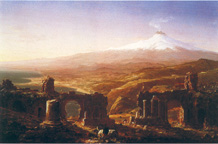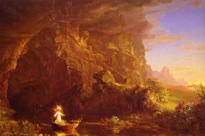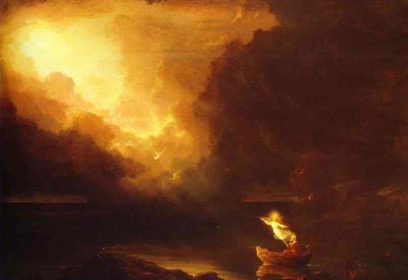“Without stories we do not know who we are, nor what we might become.”
Stories
“Without stories we do not know who we are, nor what we
might become.”
![]()
A story is one means of making sense of the world.
Winslow Homer, Breezing Up, 1873-1876.
Seven parts of a narrative structure | Putting the parts together | Emotional content of stories | Contrasting simple versus complex tales
![]()
A. Tell or give the gist or significant facts that make up the narrative.
"Writing is an extreme privilege but it's also a gift.
It's a gift to yourself and it's a gift of giving a story to someone."
Amy Tan
B. Then develop collateral stories and tie these main events together.
C. While a story builds to a climax and an eventual dénouement from an introduction of the characters, setting, dialogue, and action, it also tells us something about the world; or at least how the story-teller views the world.
"A great change was blowing up in Europe, greater perhaps even than the religious and political upheaval that" the Protestant Reformation created.
Jan Vermeer, Young Woman with a Pearl Earring, 1665-67. Every story has characters, the artist Vermeer has told a story in her attire & earring in this painting.
Oil on Canvas from the Museum which is Mauritshuis, The Hague, Netherlands.
![]()
Narrative, or story, fable or tale all have a structure within which characters and events take place; what are the component parts?
Image (s) have a Content & Frame of the activities in the story.
The content here in this cartoon from the "Evening Telegram," a now defunct, New York City newspaper, is explained in the caption and the framework is a familiar city street with unfamiliar bulls and bears pulling a wagon; Without understanding that these two women were outstanding investors and money-makers in the period just before the great crash of 1872, the meaning of the content framed in the "street-of-investments" is lost. So this cartoon depicts an historical narrative that needs interpretation for the figures to have meaning for people 140 years later.
Seven parts of a narrative structure | Putting the parts together | Emotional content of stories | Contrasting simple versus complex tales
Story line is the narrative way of formulating events into a structure; called the event structure.

Thomas Cole, Mount Etna, (volcano) from Taormina ruins, Italy: 1844.
In his painting Cole's landscape is the framework because it frames an important Romantic era literary and artistic theme of death, decay, and nature as ultimate arbiters of the human condition.
Meaning is derived from the characters, setting, plot, dialogue, actions, facts, and interpretations expressed by an author. We call the entirety of these means of conveying the story-line the exposition of these pieces that the writer arranges into the narrative sequence of a story.
Who refers to the characters, explanations of their behavior, actions, or thoughts.
What refers to the action, dialogues and descriptions of significant events that transpire.
When refers to the duration of the action and at what part of the sequence something occurred.
Where refers to the setting of the event, or place of the characters' encounters.
How is the way these ingredients come together and fit into the narrative of the situations composing the story line. The means used to derive interest in and hold attention to a story.
Writing as an art | Writing's essential qualities | Writing on structure | writing | thesis statements
The parts of any narrative are listed here grouped in seven related divisions.
![]()
Preconditions, the buildup, the main event, purpose, wind down, the result, consequences
![]()
1) Preconditions, or background is part of the story's frame. The context of any story must be framed or set within some perceivable framework. The more details in the background the greater depth there is to the "frame of reference" the writer has to evoke in the readers.
2) the buildup, this part links the story's frame to key events.
3) the main event, or climax is where the story's high point happens; could be a series of events, clashes, conflict or display of the underlying tension.
4) purpose, is the part of the story where the point is examined. The meaning of the main events are explained or revealed.
5) wind down, or dénouement; the part of the story when we learn if reconciliation, continued conflict, or return to a clear set of pre-existing or new conditions occurred.
6) the result, where the point is explained in terms of what occurred. The outcome or conclusion to the tale.
7) consequences, moral or lessons derived from the story's content. What is the reader supposed to have understood when finishing the reading?
Seven parts of a narrative structure | Putting the parts together | Emotional content of stories | Contrasting simple versus complex tales
Putting the story's seven parts together is a "story board."
Story board is
– a series of smaller picture frames that contribute to the larger image.
 |
||||
| Birth |
Childhood |
Youth |
Age |
Death |
A story board is a device used -- like a set of note cards-- to set up a frame of reference for a narrative; hence any story-board is an organizing means to describe the narrative, or a mechanism to sequentially develop the meaning of a series of events.
Use a series of post-able cards or sheets to separate the action, events, people and flow of the narrative:
| Start | Finish | ||||||
|
Preconditions |
buildup |
main
event |
purpose |
wind
down |
results |
consequences |
That framework derived from a story board is a sequence of events that conveys a specific, ordered, sequential and effective way to convey to others what happened, or what you want any reader or audience to think what happened in a significant event or series of circumstances that move the narrative from one scene to another.
Understanding a story and the use of the story board by an analogy to a person's life,
| Thomas Cole's allegorical paintings of life's journey. | ||
|---|---|---|
 |
 |
 |
| Childhood | Youth | Old age |
any narrative is built-up in stages:
Seven parts of a narrative structure | Putting the parts together | Emotional content of stories | Contrasting simple versus complex tales
![]()
Emotional structures of narratives:
The bad apple excuse
Heroes and anti-heroes
Structure of a simple narrative
Short story – Washington Irving's, The Legend of Sleepy Hollow, from the Knickerbocker Tales.
 Seven parts of a narrative structure | Putting the parts together | Emotional content of stories | Contrasting simple versus complex tales
Seven parts of a narrative structure | Putting the parts together | Emotional content of stories | Contrasting simple versus complex tales
Writing | thesis statements | writing from texts | how to approach writing | writing papers | writing & world views
![]()
The Source is:
George Lakoff, The Political Mind.
![]()
Society | Dimension | Genetics Index | Geology | Global Warming | Nature | Population | Science Index
Technology index
landscape index
words index
photograph index